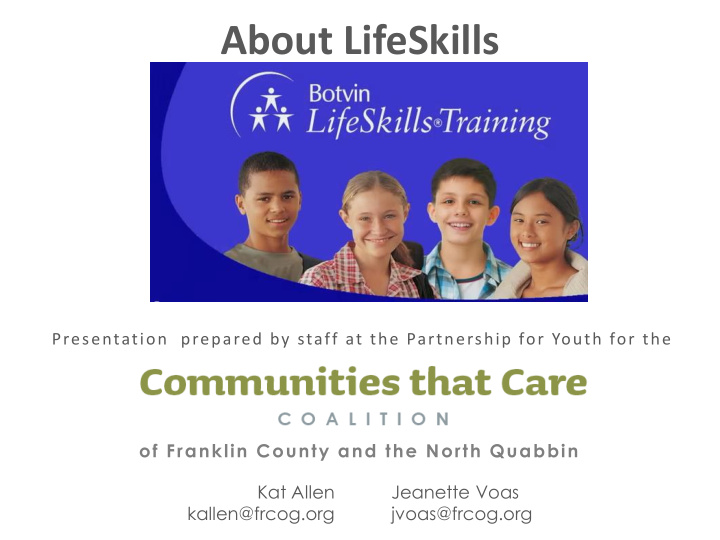



About LifeSkills Presentation prepared by staff at the Partnership for Youth for the of Franklin County and the North Quabbin Kat Allen Jeanette Voas kallen@frcog.org jvoas@frcog.org
LifeSkills is a Substance Abuse and Violence Prevention Curriculum for Middle School Students Year 1 Year 2 Year 3 6 th /7 th 7 th /8 th 8 th /9 th 15 classes 10 classes 5 classes
LifeSkills Teaches Life Skills: Self-Image & Self-Improvement Making Decisions Coping with Anxiety Coping with Anger Communication Skills Social Skills …as well as: Assertiveness Smoking: Myths and Realities Resolving Conflicts Alcohol: Myths and Realities Media Influences Marijuana: Myths and Realities Advertising Drug Abuse and Violence: Violence and the Media Causes and Effects Resisting Peer Pressure
LifeSkills Can Be Taught: In Health class, Advisory, Social Studies, or any other course. All in one course or shared between multiple courses. As often as one class per day or as infrequently as one class per week. LifeSkills Must Be Taught: With all of the required sessions. With all of the required topics. In the specified order.
LifeSkills is Evidence-Based LifeSkills has been evaluated in 30+ studies involving hundreds of schools and tens of thousands of students. It has received an alphabet soup of accolades: SAMHSA DOE DOJ NREPP CSAP NIDA AMA ONDCP CDC APA
LifeSkills Has Been Tested in Practice An estimated 50,000 teachers, 10,000 sites, and 3,000,000 students have participated in the LifeSkills program.
LifeSkills Prevents Substance Use 15% control LST Randomized trials show LifeSkills 87% less Percent of students using reduces tobacco, use 10% alcohol and marijuana 60% use among 75% less less participants relative use use 5% to controls, up to 87% for tobacco use, up to 60% for alcohol use, 0% and up to 75% for tobacco alcohol marijuana marijuana use.
LifeSkills Prevents Narcotic Prescription Drug Misuse High-risk sample, long-term follow-up Control LST 39% 38% 30% 18% 12% 11% 10% 4% 19 yrs old 20 yrs old 21 yrs old 22 yrs old Age at follow-up
LifeSkills Prevents Violence and Delinquency control LST 30% 30% 42% reduction reduction % of students with behavior 40% 20% reduction 40% reduction 10% 0% physical aggression verbal aggression delinquency fighting
LifeSkills Prevents Other Risky Behaviors • By addressing underlying social and psychological issues, and by building student skills and confidence, LifeSkills reduces a variety of risky behaviors , not just those explicitly covered in the curriculum. • For example, research has shown an impact on prescription drug use, HIV risk behaviors, and risky driving .
LifeSkills Has Lasting Effects Two studies involving more than 7000 students found that 12 th graders who had received the LifeSkills program in 7 th grade were from 16% to 23% less likely to have ever smoked cigarettes or used marijuana, or to have smoked heavily or been drunk in the past month. Another study that followed students for 12 years into their mid-20s found that those who had participated in LifeSkills in 7 th grade were: • 23% less likely to have ever used illicit drugs • 22% less likely to have used marijuana • 26% less likely to have misused prescription drugs
LifeSkills Is Cost Effective • Four cost effectiveness studies estimate that LifeSkills saves from $21 to $50 for every dollar invested. • Savings considered are in reduced corrections costs, welfare and social services burden, drug and mental health treatment; and increased employment and tax revenue.
Who Benefits from LifeSkills? • While LifeSkills is a universal prevention strategy, highest risk groups benefit most. • Research has shown LifeSkills benefits boys and girls of all races and ethnicities, in urban and rural settings .
Presentation prepared by staff at the Partnership for Youth for the of Franklin County and the North Quabbin Kat Allen Jeanette Voas kallen@frcog.org jvoas@frcog.org
More recommend